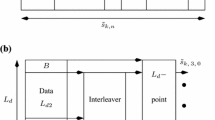Abstract
We propose two signaling schemes that exploit the availability of multiple (N) antennas at the transmitter to provide diversity benefit to the receiver. This is typical of cellular radio systems where a mobile is equipped with only one antenna while the base station is equipped with multiple antennas. We further assume that the mobile-to-base and base-to-mobile channel variations are statistically independent and that the base station has no knowledge of the base-to-mobile channel characteristics. In the first scheme, a channel code of lengthN and minimum Hamming distanced min≤N is used to encode a group ofK information bits. Channel code symbolc i is transmitted with thei th antenna. At the receiver, a maximum likelihood decoder for the channel code provides a diversity ofd min as long as each transmitted code symbol is subjected to independent fading. This can be achieved by spacing the transmit antennas several wavelengths apart. The second scheme introduces deliberate resolvable multipath distortion by transmitting the data-bearing signal with antenna 1, andN−1 delayed versions of it with antennas 2 throughN. The delays are unique to each antenna and are chosen to be multiples of the symbol interval. At the receiver, a maximum likelihood sequence estimator resolves the multipath in an optimal manner to realize a diversity benefit ofN. Both schemes can suppress co-channel interference. We provide code constructions and simulation results for scheme 1 to demonstrate its merit. We derive the receiver structure and provide a bound on the error probability for scheme 2 which we show to be tight, by means of simulations, for the nontrivial and perhaps the most interesting caseN=2 antennas. The second scheme is backward-compatible with two of the proposed digital cellular system standards, viz., GSM for Europe and IS-54 for North America.
Similar content being viewed by others
References
W. C. Jakes, Jr. (ed.),Microwave Mobile Communications, John Wiley & Sons, New York, 1974.
P. S. Henry and B. S. Glance, A new approach to high-capacity digital mobile radio,Bell Systems Technical Journal, Vol. 60, No. 8, pp. 1891–1904, October 1981.
J. H. Winters, J. Salz, and R. D. Gitlin, The impact of antenna diversity on the capacity of wireless communication systems, to appear inIEEE Transactions on Communications.
J. E. Mazo, Faster than Nyquist signaling,Bell Systems Technical Journal, Vol. 54, pp. 1451–1462, October 1975.
A. Hiroike, F. Adachi, and N. Nakajima, Combined effects of phase sweeping transmitter diversity and channel coding,IEEE Transactions on Vehicular Technology, Vol. 41, pp. 170–176, May 1992.
G. D. Forney, Jr., Maximum-likelihood sequence estimation of digital sequences in the presence of intersymbol interference,IEEE Transactions on Information Theory, Vol. IT-18, No. 5, pp. 363–378, May 1972.
G. Ungerboeck, Adaptive maximum-likelihood receiver for carrier modulated data-transmission systems, Vol. COM-22, No. 5, pp. 624–636, May 1974.
J. G. Proakis,Digital Communications, 2nd ed., McGraw-Hill, New York, 1989.
S. Huszar and N. Seshadri, Trellis equalization for digital cellular radio, unpublished AT&T Bell Laboratories report.
P. Balaban and J. Salz, Dual diversity combining and equalization in digital cellular mobile radio,IEEE Transactions on Vehicular Technology, Vol. 40, No. 2, pp. 342–354, May 1991.
J. E. Mazo, Exact matched filter bound for two-beam Rayleigh fading,IEEE Transactions on Communications, Vol. 39, No. 7, pp. 1027–1030, July 1991.
A. Wittneben, Base station modulation diversity for digital SIMULCAST,41st IEEE Vehicular Technology Society Conference Proceedings, pp. 848–853.
G. Ungerboeck, Channel coding with multilevel/phase signals,IEEE Transactions on Information Theory, Vol. 1T-28, No. 1, pp. 55–67, January 1982.
E. Biglieri, D. Divsalar, P. J. McLane, and M. K. Simon,Introduction to Trellis-Coded Modulation with Applications, Macmillan Publishing Company, New York, 1991.
S. G. Wilson and Y. S. Leung, Trellis-coded phase modulation on Rayleigh channels,ICC'87, Conf. Proc, Seattle, Washington, June 1987, pp. 739–743.
L.-F. Wei, Block coded M-DPSK with built-in time diversity for fading channels, submitted toIEEE Transactions on Information Theory.
N. Seshadri and C.-E. W. Sundberg, Multi-level block coded modulations for the Rayleigh fading channel,GLOBECOM'91, Phoenix, Arizona, December 2–5, 1991.
A. Duel-Hallen and C. Heegard, Delayed decision-feedback sequence estimation,IEEE Transactions on Communications, Vol. 37, No. 5, pp. 428–436, May 1989.
J. Salz, Digital transmission over cross-coupled linear channels,Bell Systems Technical Journal, Vol. 64, July–August 1985.
M. S. Mueller and J. Salz, A unified theory of data-aided equalization.Bell Systems Technical Journal, Vol. 60, No. 9, pp. 2023–2038, November 1991.
M. L. Honig, P. Crespo, and K. Steiglitz, Suppression of near- and far-end crosstalk by linear pre- and post-filtering,IEEE Journal on Selected Areas in Communications, Vol. 10, No. 3, pp. 614–629, April 1992.
Author information
Authors and Affiliations
Rights and permissions
About this article
Cite this article
Seshadri, N., Winters, J.H. Two signaling schemes for improving the error performance of frequency division duplex (FDD) transmission systems using transmitter antenna diversity. Int J Wireless Inf Networks 1, 49–60 (1994). https://doi.org/10.1007/BF02117292
Issue Date:
DOI: https://doi.org/10.1007/BF02117292




